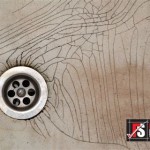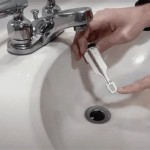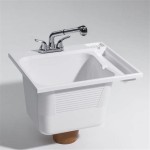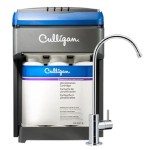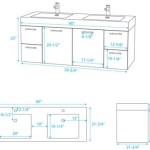35 Inch Vanity With Sink: A Comprehensive Guide
The 35-inch vanity with sink represents a popular choice for homeowners seeking a balance between functionality and space efficiency in their bathrooms. It offers adequate storage and countertop space without overwhelming smaller to medium-sized bathrooms. This article will provide a comprehensive overview of 35-inch vanities with sinks, covering various aspects such as design considerations, material options, installation tips, and maintenance recommendations.
When selecting a 35-inch vanity with sink, several factors warrant careful consideration. The overall aesthetic of the bathroom, the available plumbing configuration, and the desired storage capacity are all critical determinants. Ignoring these elements can lead to dissatisfaction with the final result. Understanding the nuances of each aspect ensures the chosen vanity not only meets functional needs but also complements the overall design scheme.
Key Point 1: Design and Style Considerations
The design of a 35-inch vanity can significantly impact the overall feel of the bathroom. Vanities are available in a wide array of styles, ranging from traditional and classic designs to modern and contemporary interpretations. The selection process should include a consideration of the existing bathroom fixtures and décor to ensure a cohesive and harmonious look.
Traditional vanities often feature ornate details, raised panel doors, and classic hardware. These vanities are typically constructed from solid wood, lending a sense of timeless elegance. They are well-suited for bathrooms with a more formal or traditional aesthetic. The inherent character of wood, with its grain and texture, can add warmth and sophistication to the space.
Modern vanities typically exhibit clean lines, minimalist designs, and a focus on functionality. They often incorporate materials such as glass, metal, and engineered wood. These vanities are ideal for bathrooms with a contemporary or minimalist design scheme. The streamlined aesthetic creates a sense of spaciousness and order.
Transitional vanities represent a blend of traditional and modern design elements. They often feature clean lines with subtle detailing, making them versatile enough to complement a variety of bathroom styles. This style offers a balanced approach, allowing for integration into diverse aesthetic preferences.
Beyond overall style, the type of mounting is also a crucial design consideration. Wall-mounted vanities, also known as floating vanities, create a sense of spaciousness by freeing up floor space. These vanities are particularly well-suited for smaller bathrooms, as they make cleaning easier and can visually expand the room. However, they require proper wall reinforcement to support the weight of the vanity and its contents.
Floor-mounted vanities, also known as freestanding vanities, offer more stability and are generally easier to install. They provide a solid foundation and ample storage space. The downside is that they can make the bathroom feel more cramped, especially in smaller spaces. The choice between wall-mounted and floor-mounted depends on individual preferences and the specific constraints of the bathroom layout.
Key Point 2: Material Options and Sink Types
The materials used in the construction of a 35-inch vanity influence its durability, aesthetic appeal, and maintenance requirements. Selecting the right material is essential for ensuring the vanity withstands the humid bathroom environment and continues to look its best for years to come.
Solid wood is a popular choice for vanities due to its durability and natural beauty. Hardwoods like oak, maple, and cherry are particularly resistant to moisture and wear. However, solid wood vanities can be more expensive than those made from other materials. Regular sealing and maintenance is required to prevent water damage and warping.
Plywood is another common material used in vanity construction. High-quality plywood offers good stability and resistance to warping and cracking. It is often used in conjunction with a veneer of solid wood to achieve the desired aesthetic. Plywood is a cost-effective alternative to solid wood, while still providing satisfactory structural integrity.
Manufactured wood products like MDF (Medium-Density Fiberboard) are also widely used in vanity construction. MDF is a dense and uniform material that is less prone to warping than solid wood. However, it is susceptible to water damage if not properly sealed. MDF vanities are typically more affordable than solid wood or plywood vanities.
The sink type is an integral part of the vanity assembly. There are several sink types commonly used with 35-inch vanities, each with its own advantages and disadvantages.
Undermount sinks are installed beneath the countertop, creating a seamless and easy-to-clean surface. They offer a modern and minimalist look and are well-suited for bathrooms with a contemporary design scheme. The countertop edge is exposed, requiring a durable and water-resistant material.
Vessel sinks sit on top of the countertop, creating a dramatic and eye-catching focal point. They come in a wide variety of shapes, sizes, and materials, allowing for a high degree of customization. However, vessel sinks can be more prone to splashing and may require a taller faucet.
Integrated sinks are molded directly into the countertop, creating a seamless and hygienic surface. They are often made from materials such as solid surface or cultured marble. Integrated sinks are easy to clean and maintain, but they offer less design flexibility than other sink types.
Drop-in sinks, also known as self-rimming sinks, are installed into a pre-cut hole in the countertop. They are relatively easy to install and offer a wide range of styles and materials. However, the rim of the sink can trap dirt and debris.
Key Point 3: Installation and Maintenance
Proper installation is critical for ensuring the longevity and functionality of a 35-inch vanity with sink. While some homeowners may choose to tackle the installation themselves, it is often advisable to hire a professional plumber to ensure the job is done correctly.
Before beginning the installation process, carefully measure the available space and ensure the vanity will fit properly. Check the plumbing connections and make sure they are compatible with the vanity's drain and water supply lines. Turn off the water supply to the bathroom before disconnecting the old vanity.
When installing a wall-mounted vanity, it is essential to locate the wall studs and use appropriate hardware to securely mount the vanity. Failure to properly secure the vanity can result in it pulling away from the wall, causing damage to the vanity and the surrounding area.
Once the vanity is installed, connect the drain and water supply lines, ensuring all connections are tight and leak-free. Use plumber's tape on threaded connections to prevent leaks. After the connections are made, turn on the water supply and check for any leaks.
Regular maintenance is essential for keeping a 35-inch vanity with sink looking its best. Clean the vanity regularly with a mild soap and water solution. Avoid using abrasive cleaners, as they can damage the finish. Wipe up any spills immediately to prevent staining.
For solid wood vanities, periodically apply a sealant or polish to protect the wood from moisture. Inspect the plumbing connections regularly for leaks and address any issues promptly. Keep the bathroom well-ventilated to prevent the buildup of moisture and mold.
Pay attention to the hardware on the vanity. Clean hinges, pulls, and knobs regularly. If metal is used consider a metal polish on an annual basis to preserve sheen and prevent tarnishing. Wood finishes may require gentle cleaning and application of a wood cleaner to maintain the luster of the finish.
Consider placing small, non-abrasive pads or protectors on the bottom of items placed on the countertop to prevent scratching. This simple preventative measure goes a long way in preserving the appearance of the countertop over an extended period. Additionally, avoid setting extremely hot items directly on the countertop without protection as heat can damage certain materials.
Finally, routinely check the caulking around the sink's perimeter where it meets the countertop. Over time, caulking can crack or degrade, allowing water to seep behind the vanity which can cause damage and promote mold growth. Inspect and replace when necessary, or ideally, preventatively, to maintain a tight seal.

Unbranded 35 5 In W X 17 7 D H Bathroom Vanity White Solid Frame Cabinet With Ceramic Basin Top Vcw 12233

35 5 In W X 17 7 D H Bathroom Vanity Cabinet Gray With Drawers White Ceramic Sink Top

The Bella Collection 35 Inch Single Sink White Vanity Base Only

36 In W X 22 D 35 H Solid Wood Bath Vanity White With Carrara Quartz Top Single Sink Soft Close Drawers

35 Floating Bathroom Vanity With Cultured Marble Top Sink Homary

35 Bathroom Vanity With Tempered Glass Vessel Sink Cabinet W 3 Drawer

35 5 Inch Single Sink Bathroom Vanity With A Dark Walnut Finish

35 Bathroom Vanity Freestanding Cultured Marble Top With Single Sink Drawers White

Elegant Lighting Vf12348bl Otto 48 X 21 35 Inch Blue Vanity Sink Set

James In Bristol 36 Bright White Single Vanity W 3 Cm Arctic Fall Solid Surface Top
